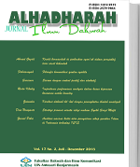Pemberdayaan Ekonomi Masyarakat Islam Berbasis Masjid (Studi Kasus Pemberdayaan Yatim Masjid Ar Rahmah Surabaya)
DOI:
https://doi.org/10.18592/alhadharah.v22i1.7578Abstract
In the actualization of proselytizing bil hal, economic empowerment becomes a concrete step. Economic Empowerment is a strategic step to alleviate poverty. This research raises how mosques carry out orphan empowerment with the perspective of proselytizing bil hal. The purpose of this study is to find out how the implementation of da'wah bil hal through the orphan empowerment program organized by the Ar Rahmah Perak Mosque in Surabaya. This research uses a qualitative approach. Data collection techniques are carried out through, observation, interviews, and document studies. The collected data are analyzed with a Grounded theory Analysis. The results of this study show the strategic role of mosques in breaking the chain of poverty through the empowerment of orphans. The Empowerment Program is packaged in a comprehensive and long-term oriented strategy, including compensation and fulfillment of daily needs, educational scholarships up to the undergraduate level as well as efforts to provide jobs for orphans' mothers. The results of this study can be useful as an alternative model for poverty alleviation in Indonesia as a form of proselytizing bil hal inner mosque. This research also emphasizes the social function of mosques as centers of people's problems.References
Abdullah. 2015. “Ilmu Dakwah.” In , edited by Muhammad Yunus Nasution, Pertama, 30. Bandung: Cita Pustaka Media.
Afif, Mufti. 2020. “Fungsi Masjid Dalam Mengelola Dana Ziswah Sebagai Instrumen Pemberdayaan Ekonomi Umat.” Islamic Economics and Philanthropy 03 (02): 749–72.
Alwi, Muhammad Muhib. 2020. “Pemberdayaan Ekonomi Masyarakat Berbasis Masjid Di Tengah Pandemi Covi-19.” Alhikmah : Jurnal Ilmu Dakwah 18 (1): 89–104.
Gazalba, Sidi. 1986. “Masjid Pusat Peradaban Dan Kebudayaan Islam.” In . Jakarta: Bulan Bintang.
Gioia, Dennis A., Kevin G. Corley, and Aimee L. Hamilton. 2013. “Seeking Qualitative Rigor in Inductive Research.” Organizational Research Methods 16 (1): 15–31. https://doi.org/10.1177/1094428112452151.
Kurniawati, Dwi Pratiwi, Bambang Supriyono, and Imam Hanafi. 2013. “Pemberdayaan Masyarakat Di Bidang Usaha Ekonomi (Studi Pada Badan Pemberdayaan Masyarakat Kota Mojokerto).” Jurnal Administrasi Publik 1 (4): 9–14. http://administrasipublik.studentjournal.ub.ac.id/index.php/jap/article/view/129/113.
Marjayanti, Dian. 2017. “Strategi Pengembangan Masjid Cheng Hoo Berbasis Kemandirian.”
Marni, Karjuni Dt. 2011. “Teori ACTORS Dalam Pemberdayaan Masyarakat.” Demokrasi, 14.
Miradj, Safri, and Sumarno Sumarno. 2014. “Pemberdayaan Masyarakat Miskin, Melalui Proses Pendidikan Nonformal, Upaya Meningkatkan Kesejahteraan Sosial Di Kabupaten Halmahera Barat.” Jurnal Pendidikan Dan Pemberdayaan Masyarakat 1 (1): 101. https://doi.org/10.21831/jppm.v1i1.2360.
Mubarakfuri, Syafiurrahman Al. 2014. “Sirah Nabawiyah.” In Kathur Suhardi. Jakarta: Pustaka Kautsar.
Nurjamilah, Cucu. 2017. “Pemberdayaan Masyarakat Berbasis Masjid Dalam Perspektif Dakwah Nabi Saw.” Journal of Islamic Studies and Humanities 1 (1): 93–119. https://doi.org/10.21580/jish.11.1375.
Ramadhan, Abdurrahman, Idaul Hasanah, and Rahmad Hakim. 2019. “Potret Masjid Sebagai Basis Pemberdayaan Ekonomi Umat.” Iqitishodia: Jurnal Ekonomi Syariah 4 (1): 31–49.
Rochmat, Muchlison. 2020. “Nabi Muhammad Bangun Ekonomi Umat Dengan Mendirikan Pasar.” Nu Online. 2020.
https://islam.nu.or.id/sirah-nabawiyah/nabi-muhammad-bangun-ekonomi-umat-dengan-mendirikan-pasar-lyNMp.
Shihab, M Quraish. 1996. “Wawasan Al Qur’an.” In . Bandung: Mizan.
Shihab, Quraish. 2016. Membumikan Al-Qur’an. Edited by Sidiq. 1st ed. Jakarta: Mizan.
Soetomo. 2011. “Pemberdayaan Masyarakat : Mungkinkah Mucul Antitesisnya?” In . Yogyakarta: Pustaka Pelajar.
Yusuf Qordowi. 1996. Tsaqofah Ad-Da’iyah.
Downloads
Published
How to Cite
Issue
Section
License
Copyright (c) 2023 Muh Syahril Sidik Ibrahim, Muhammad Rifaid, Ahmad Faiz Khudlari Thoha, Mauludi Mauludi

This work is licensed under a Creative Commons Attribution-NonCommercial 4.0 International License.
Authors retain copyright and grant the journal the right of first publication, with the work simultaneously licensed under the Creative Commons Attribution-NonCommercial 4.0 International Public License (CC BY-NC 4.0). This license allows reusers to distribute, remix, adapt, and build upon the material in any medium or format for noncommercial purposes only, provided that proper attribution is given to the original creator.







